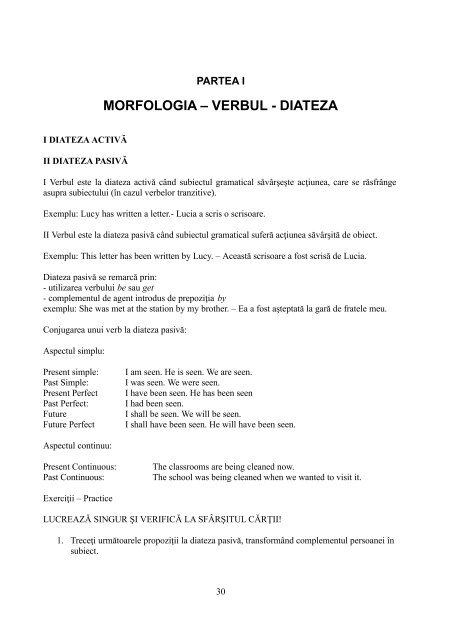Invata-Engleza-Fara-Profesor
Create successful ePaper yourself
Turn your PDF publications into a flip-book with our unique Google optimized e-Paper software.
PARTEA I<br />
MORFOLOGIA – VERBUL - DIATEZA<br />
I DIATEZA ACTIVĂ<br />
II DIATEZA PASIVĂ<br />
I Verbul este la diateza activă când subiectul gramatical săvârşeşte acţiunea, care se răsfrânge<br />
asupra subiectului (în cazul verbelor tranzitive).<br />
Exemplu: Lucy has written a letter.- Lucia a scris o scrisoare.<br />
II Verbul este la diateza pasivă când subiectul gramatical suferă acţiunea săvârşită de obiect.<br />
Exemplu: This letter has been written by Lucy. – Această scrisoare a fost scrisă de Lucia.<br />
Diateza pasivă se remarcă prin:<br />
- utilizarea verbului be sau get<br />
- complementul de agent introdus de prepoziţia by<br />
exemplu: She was met at the station by my brother. – Ea a fost aşteptată la gară de fratele meu.<br />
Conjugarea unui verb la diateza pasivă:<br />
Aspectul simplu:<br />
Present simple:<br />
Past Simple:<br />
Present Perfect<br />
Past Perfect:<br />
Future<br />
Future Perfect<br />
I am seen. He is seen. We are seen.<br />
I was seen. We were seen.<br />
I have been seen. He has been seen<br />
I had been seen.<br />
I shall be seen. We will be seen.<br />
I shall have been seen. He will have been seen.<br />
Aspectul continuu:<br />
Present Continuous:<br />
Past Continuous:<br />
The classrooms are being cleaned now.<br />
The school was being cleaned when we wanted to visit it.<br />
Exerciţii – Practice<br />
LUCREAZĂ SINGUR ŞI VERIFICĂ LA SFÂRŞITUL CĂRŢII!<br />
1. Treceţi următoarele propoziţii la diateza pasivă, transformând complementul persoanei în<br />
subiect.<br />
30



